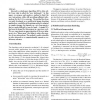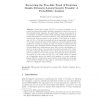654 search results - page 40 / 131 » On the Approximation of Computing Evolutionary Trees |
CEC
2005
IEEE
15 years 3 months ago
2005
IEEE
AbstractInteractive evolutionary algorithms (IEA) often suffer from what is called the “user bottleneck.” In this paper, we propose and analyse a method to limit the user inter...
CIG
2005
IEEE
15 years 3 months ago
2005
IEEE
Abstract- In this paper, we apply an Evolutionary Algorithm (EA) to solve the Rubinstein’s Basic AlternatingOffer Bargaining Problem, and compare our experimental results with it...
BMCBI
2005
14 years 9 months ago
2005
Background: Distance-based methods are popular for reconstructing evolutionary trees thanks to their speed and generality. A number of methods exist for estimating distances from ...
118
click to vote
RECOMB
2012
Springer
13 years 4 days ago
2012
Springer
Abstract. Lateral gene transfer (LGT) is a common mechanism of nonvertical evolution where genetic material is transferred between two more or less distantly related organisms. It ...
PPSN
2010
Springer
14 years 8 months ago
2010
Springer
The hypervolume indicator is widely used to guide the search and to evaluate the performance of evolutionary multi-objective optimization algorithms. It measures the volume of the ...


